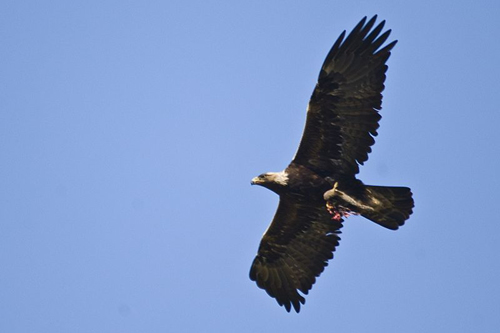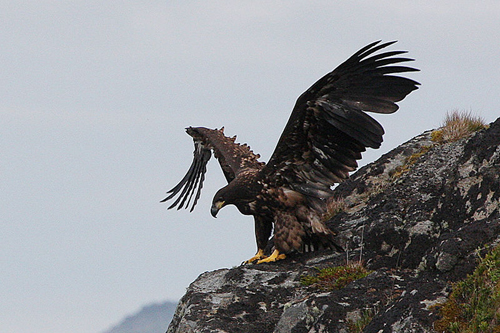EAGLES may now be a rarely-glimpsed symbol of the Scottish Highlands but their domain once stretched as far south as the English Channel.
Scots scientists have found that the birds were far more abundant 1500 years ago than ever imagined.
The team used old place names and historic documents to work out where golden and white-tailed eagles were once found – before falling victim to human persecution.
Golden eagles are still victims of poisoning Photo:Chuck Abbe
The study by RSPB Scotland shows white-tailed eagles, also known as sea eagles, could be found across the country from Shetland to the English Channel in around 500AD, while golden eagles lived more closely together but could still be found in all parts of the UK.
But by 1800AD Golden eagle numbers had dropped by two thirds, with just 300-500 breeding pairs left, down from 1000-1500 pairs in 500AD.
The number of white-tailed eagles dropped by 90% and by 1920 they were totally extinct in the UK.
While the Golden eagle had clung on, it was limited to the Highlands, Skye and Harris.
The reintroduction of the white-tailed eagle, the UK’s biggest bird of prey, has seen around 40 breeding pairs take hold in a fraction of the species’ former territory, while golden eagle numbers sit at around 400.
The reintroduction of the white-tailed eagle has been criticised by crofters and gamekeepers, who have accused them of attacking livestock, while the golden eagle still falls victim to illegal poisoning.
The study’s authors hope the findings will aid conservation efforts but showing where the birds were once found naturally.
The white-tailed eagle has been reintroduced to Scotland Photo:Snowmanradio
Richard Evans, of RSPB Scotland and lead author of the study, said: “The really big surprise for us was finding out just how widespread eagles once were in the south of Scotland and England.
“It shows the scale of what has been lost between then and now – but also the potential for the future.
“The results provide compelling evidence eagles were widespread throughout Britain and Ireland in the Dark Ages.
“Between the years 500 and 1800 we see massive loss of eagle range in the south, which is consistent with the effects of habitat loss and killing by humans, rather than the influence of climate change on habitat, or competitive exclusion, as some have suggested.
“This trend continued in the years up to the First World War, until the only eagles left in all of Britain and Ireland were golden eagles in the highest hills and deer forests of Scotland.
“Recovery of golden eagles since this low point has stalled, while limited recovery of white-tailed eagles has only been possible by reintroduction.
“Although the reintroduced white-tailed eagle population is healthy, at present they occupy only a fraction of their former range.”
Duncan Orr-Ewing, RSPB Scotland’s head of species and land management, said: “Reintroduction and other conservation efforts supported by many land managers are now attempting to restore our native eagle species across their former range.
“This study will help to inform current and future eagle recovery programmes in the UK by improving our understanding of where these species should naturally occur in our landscapes.”
Environment Minister Stewart Stevenson said: “Birds of prey are an important part of Scotland’s biodiversity and our eagles are hugely popular with locals and visitors alike.
“The recent marked increase in sea eagles demonstrates how conservation and management efforts are beginning to make a real difference for these beautiful and iconic birds.
“The Scottish Government is committed to working with our partners to tackle eagle persecution, with 2011 figures showing a welcome reduction in poisoning incidents for birds of prey.”



